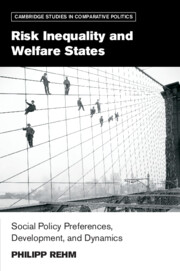Book contents
- Frontmatter
- Dedication
- Contents
- List of Figures
- List of Tables
- Acknowledgments
- 1 Introduction
- 2 Theoretical Framework
- 3 Preference Formation
- 4 Risk Perceptions
- 5 Risk Pools and Social Policy Generosity
- 6 Risk Pools and Retrenchment – German Reunification
- 7 Risk Pools and Social Policy Adoption
- 8 Crises and Social Policy
- 9 Conclusion
- References
- Index
- Other Books in the Series
8 - Crises and Social Policy
Published online by Cambridge University Press: 05 May 2016
- Frontmatter
- Dedication
- Contents
- List of Figures
- List of Tables
- Acknowledgments
- 1 Introduction
- 2 Theoretical Framework
- 3 Preference Formation
- 4 Risk Perceptions
- 5 Risk Pools and Social Policy Generosity
- 6 Risk Pools and Retrenchment – German Reunification
- 7 Risk Pools and Social Policy Adoption
- 8 Crises and Social Policy
- 9 Conclusion
- References
- Index
- Other Books in the Series
Summary
The stock market crash in October 1929 marked the onset of the Great Depression in the United States. The Dow Jones Industrial Average lost almost 90 percent of its value, wiping out the retirement savings of many Americans. It took until November 1954 to recover these losses. Between 1929 and 1933, industrial production declined by almost 50 percent and real GDP fell by almost 30 percent. Unemployment soared from 1–3 percent in 1929 to about 25 percent in 1933. Poverty and material deprivation were widespread. Suicide rates increased from 10.2 per 100,000 in 1920, to 13.9 in 1929, and to 17.4 in 1932, the highest American figure on record. Suicide rates among those aged 55–74 reached astronomic figures with 50 suicides per 100,000 elderly (Luo et al. 2011).
In 1933, President Franklin Delano Roosevelt took office and started implementing the New Deal legislation, which culminated in the Social Security Act in 1935. The law, which introduced mandatory old age and unemployment insurance (UI) in America, was passed with broad bipartisan support, winning more than 80 percent of the votes in both the House and the Senate. These social insurance programs were extended over time, are still in existence today, are at least as generous as typical European programs (Alber 2010), and generally enjoy widespread support.
It is difficult to overestimate the importance of the Great Depression for the adoption of the Social Security Act, a milestone in the history of Western welfare states. Historical counterfactuals are notoriously speculative, but many observers would agree that “absent the depression, social security might not have been created at all” (Miron and Weil 1998, 298), and that something similar could be said about UI. Of course, history is complex, and “the New Deal was the result of a unique concatenation of forces” that led to an ideological shift “from widespread skepticism about the ability of the central government to improve the functioning of the economy to widespread faith in the competence of government” (Rockoff 1998, 125). But it is simply widely understood that America's New Deal was a consequence of the Great Depression.
- Type
- Chapter
- Information
- Risk Inequality and Welfare StatesSocial Policy Preferences, Development, and Dynamics, pp. 180 - 201Publisher: Cambridge University PressPrint publication year: 2016

